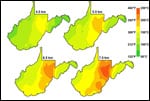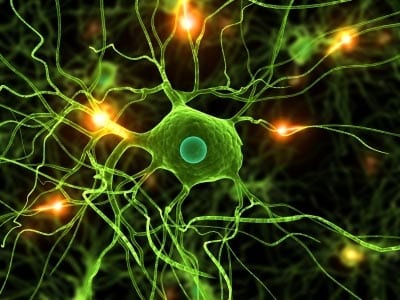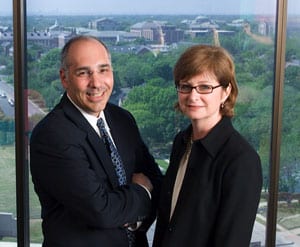Paleontologists propose the new term “digitype” for full-resolution three-dimensional digital models that preserve and archive endangered fossils
Portable laser scanning technology allows researchers to tote their latest fossil discovery from the field to the lab in the form of lightweight digital data stored on a laptop. But sharing that data as a 3D model with others requires standard formats that are currently lacking, say paleontologists at Southern Methodist University.
The SMU researchers used portable laser scanning technology to capture field data of a huge 110 million-year-old Texas dinosaur track and then create to scale an exact 3D facsimile. They share their protocol and findings with the public — as well as their downloadable 145-megabyte model — in the online scientific journal Palaeontologia Electronica.
The model duplicates an actual dinosaur footprint fossil that is slowly being destroyed by weathering because it’s on permanent outdoor display, says SMU paleontologist Thomas L. Adams, lead author of the scientific article. The researchers describe in the paper how they created the digital model and discuss the implications for digital archiving and preservation. Click here for the download link.
“This paper demonstrates the feasibility of using portable 3D laser scanners to capture field data and create high-resolution, interactive 3D models of at-risk natural history resources,” write the authors.
“3D digitizing technology provides a high-fidelity, low-cost means of producing facsimiles that can be used in a variety of ways,” they say, adding that the data can be stored in online museums for distribution to researchers, educators and the public.
SMU paleontologist Louis L. Jacobs is one of the coauthors on the article.
“The protocol for distance scanning presented in this paper is a roadmap for establishing a virtual museum of fossil specimens from inaccessible corners across the globe,” Jacobs said.
Paleontologists propose the term “digitype” for digital models
Scientists increasingly are using computed tomography and 3D laser scanners to produce high-quality 3D digital models, say Adams and his colleagues, including to capture high-resolution images from remote field sites.
SMU’s full-resolution, three-dimensional digital model of the 24-by-16-inch Texas footprint is one of the first to archive an at-risk fossil, they say.
Book a live interview
| To book a live or taped interview with Thomas Adams in the SMU News Broadcast Studio call News and Communications at 214-768-7650 or email news@smu.edu. |
Related links
- Dinosaur Valley State Park tracks
- Paluxy River Field Trip Guide Book
- FAQ: Dinosaur tracking
 Videos: Dinosaur Valley State Park
Videos: Dinosaur Valley State Park- Dinosaur Valley State Park
- Dinosaur Valley State Park Information Guide
- Glen Rose
- Institute for the Study of Earth and Man
- Roy M. Huffington Department of Earth Sciences at SMU
- SMU’s Dedman College
More SMU Research news
The SMU paleontologists propose the term “digitype” for such facsimiles, writing in their article “High Resolution Three-Dimensional Laser-scanning of the type specimen of Eubrontes (?) Glenrosensis Shuler, 1935, from the Comanchean (Lower Cretaeous) of Texas: Implications for digital archiving and preservation.”
Laser scanning is superior to other methods commonly used to create a model because the procedure is noninvasive and doesn’t harm the original fossil, the authors say. Traditional molding and casting procedures, such as rubber or silicon molds, can damage specimens.
But the paleontologists call for development of standard formats to help ensure data accessibility.
“Currently there is no single 3D format that is universally portable and accepted by all software manufacturers and researchers,” the authors write.
Digitype is baseline for measuring future deterioration
SMU’s digital model archives a fossil that is significant within the scientific world as a type specimen — one in which the original fossil description is used to identify future specimens. The fossil also has cultural importance in Texas. The track is a favorite from well-known fossil-rich Dinosaur Valley State Park, where the iconic footprint draws tourists.
The footprint was left by a large three-toed, bipedal, meat-eating dinosaur, most likely the theropod Acrocanthosaurus. The dinosaur probably left the footprint as it walked the shoreline of an ancient shallow sea that once immersed Texas, Adams said. The track was described and named in 1935 as Eubrontes (?) glenrosensis. Tracks are named separately from the dinosaur thought to have made them, he explained.
“Since we can’t say with absolute certainty they were made by a specific dinosaur, footprints are considered unique fossils and given their own scientific name,” said Adams, a doctoral candidate in the Roy M. Huffington Department of Earth Sciences at SMU.
The fossilized footprint, preserved in limestone, was dug up in the 1930s from the bed of the Paluxy River in north central Texas about an hour’s drive southwest of Dallas. In 1933 it was put on prominent permanent display in Glen Rose, Texas, embedded in the stone base of a community bandstand on the courthouse square.
The footprint already shows visible damage from erosion, and eventually it will be destroyed by gravity and exposure to the elements, Adams said. The 3D model provides a baseline from which to measure future deterioration, he said.
In comparing the 3D model to an original 1930s photograph made of the footprint, the researchers discovered that some surface areas have fractured and fallen away. By comparing the 3D model with a synthetically altered version, the researchers were able to calculate volume change, which in turn enables reconstruction of lost volume for restoration purposes.
Model comprises 52 scans totaling 2 gigabytes
Adams and his research colleagues took a portable scanner to the bandstand site to capture the 3D images. They employed a NextEngine HD Desktop 3D scanner and ScanStudio HD PRO software running on a standard Windows XP 32 laptop. The scanner and laptop were powered from outlets on the bandstand. The researchers used a tent to control lighting and maximize laser contrast.
Because of the footprint’s size — about 2 feet by 1.4 feet (64 centimeters by 43 centimeters) — multiple overlapping images were required to capture the full footprint.
Raw scans were imported into Rapidform XOR2 Redesign to align and merge them into a single 3D model. The final 3D model was derived from 52 overlapping scans totaling 2 gigabytes, the authors said.
The full-resolution 3D digital model comprises more than 1 million poly-faces and more than 500,000 vertices with a resolution of 1.2 millimeters. It is stored in Wavefront format. In that format the model is about 145 megabytes. The model is free for downloading from a link on Palaeontologia Electronica‘s web site.
3D digital footprint also available as a QuickTime virtual object
A smaller facsimile is also available from the journal as a QuickTime Virtual Reality object. In that format, users can slide their mouse pointer over the 3D footprint image to drag it to a desired viewing angle, and zoom and pan. Click here for the link to the QuickTime video.
Besides the 3D model, included with the Palaeontologia Electronica article is a link to a pdf of the original 1935 scientific article in which SMU geology professor Ellis W. Shuler described and identified the dinosaur that made the track.
Shuler’s article, no longer in print, is “Dinosaur Track Mounted in the Band Stand at Glen Rose, Texas,” published in Field & Laboratory. The clay molds and plaster casts Shuler made of the bandstand track are now lost, Adams said. Click here for the article.
Besides Adams and Jacobs, other co-authors on the article are paleontologists Christopher Strganac and Michael J. Polcyn in the Roy M. Huffington Department of Earth Sciences at SMU.
The research was funded by the Institute for the Study of Earth and Man at SMU. — Margaret Allen
SMU is a private university in Dallas where nearly 11,000 students benefit from the national opportunities and international reach of SMU’s seven degree-granting schools. For more information see www.smu.edu.
SMU has an uplink facility on campus for live TV, radio or online interviews. To speak with Adams or to book him in the SMU studio, call SMU News & Communications at 214-768-7650.





